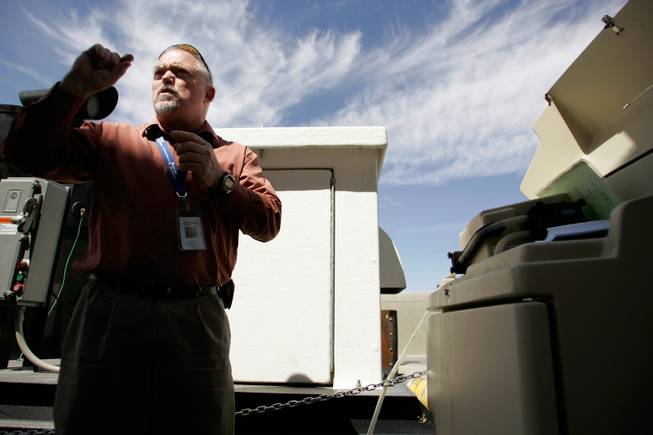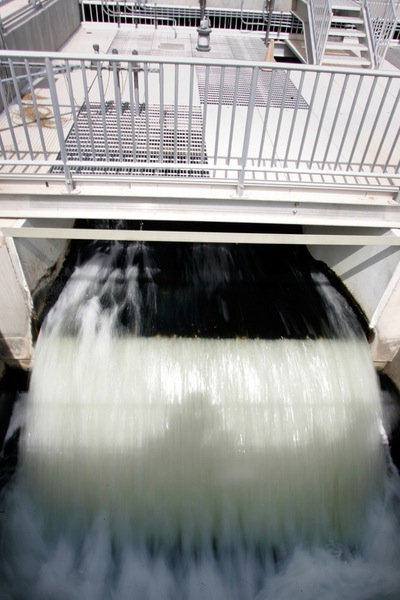
Bill Shepherd, manager of plant operations at the Clark County wastewater treatment plant, demonstrates how water samples are collected. The plant serves an estimated 841,000 people, and its untreated sewage was collected for a day for a study to identify what we ingest.
Monday, April 28, 2008 | 2 a.m.
Sun Topics
In Clark County, we take our coffee with cigarettes and ephedrine.
We know this because the Sun commissioned an Oregon State University scientist to test Clark County’s raw sewage for drugs, part of a process called “community urinalysis,” and found that on March 20, the Thursday our sewage was sampled, illegal drug levels were low, and caffeine was high.
Two times higher, in fact, than scientist Jennifer Field has seen in any of the 12 cities she tested previously.
Clark County was smoking that Thursday too. Nicotine, metabolized in the body as something called cotinine, registered very high in the test. So did ephedrine — a stimulant found in cold and allergy medicines, appetite suppressants, decongestants, and blood pressure and asthma medications.
Back alley chemists also sometimes use it to cook up methamphetamine. But the meth levels Field found in Clark County’s waste were lower than those found in the other cities. Or, as Field put it, our meth levels were “pretty unspectacular.” So were our levels of cocaine, club drugs, LSD and prescription pain pills. Why? Well, she doesn’t know exactly, and won’t speculate. She’s a cautious environmental chemist in the early stages of her research, collecting wastewater samples from across the country and trying to figure out what it all means.
So here are some Sun extrapolations: gamblers chugging coffee so they can last another six hours at a blackjack table; gamblers chugging coffee to sober up after losing their rent during six hours of blackjack; cocktail waitresses hitting those supersized Red Bulls; Southern California tourist moms pounding skim lattes; showgirls downing diet pills; night-shift workers drinking Diet Cokes.
We are, after all, a 24-hour town, more so than most places. But perhaps our reputation for vices is a little exaggerated, at least when it comes to the illegal ones.
No less than Gov. Jim Gibbons called methamphetamine “the colossal struggle of our times” during his State of the State speech last year, and set aside $17 million to fight the “scourge” of meth, but Field found our levels of the drug were lower than those of cities in the Midwest, and far lower than in another gambling city Field studied. (She won’t name names.)
Her earlier findings have been, if not concrete, then at least compelling. In an affluent community she studied, the level of cocaine was pretty low until Friday rolled around — then it went up.
Community urinalysis is more or less what it sounds like: Testing urine for drugs. The difference is that it’s drug testing an entire community at once by examining wastewater, since everybody, eventually, goes to the bathroom. Field just isolates the drugs from the sewage, and she does so on a molecular level, in extremely small amounts, nanograms per liter.
To explain just how sensitive the test is, Field gives a comparison: Finding a nanogram of methamphetamine in a liter of water is the equivalent of paving the entire state of Indiana with square-foot white tiles, and finding a single red one in the bunch.
Field found an average of 226 nanograms of cocaine per liter of Clark County wastewater, an amount so minuscule you’d have to drink 442,000 liters of raw sewage to get a one-tenth gram dose of the drug. (Field, of course, does not recommend drinking sewage.)
She needs only a teaspoon of wastewater to come up with a county average — the total amount of each drug, in milligrams, per person.
The Clark County wastewater treatment facility serves an estimated 841,000 people, and when Field averaged the numbers, she found 0.83 milligram of methamphetamine per person, 0.88 milligram of cocaine metabolite per person, 2.90 grams of ephedrine per person, 1.1 milligrams of nicotine metabolite per person, and 50 milligrams of caffeine, about one-fifth of a cup of coffee.
So maybe it’s not a few people drinking lots of coffee, but lots of people drinking a little coffee.
Getting the sewage to Field wasn’t easy. It had to be collected over 24 hours, from midnight to midnight. During this time, a few drops are siphoned off huge amounts of waste incrementally, so the final sample is a cross section of the entire day. This means handling raw sewage, which means exposure to E. coli, polio, hepatitis. This means going to the sewage plant and watching massive industrial machines separate solid waste from wet, then compress that solid waste into ton-sized “cakes” that are dropped onto trucks bound for a landfill. Plant workers say they get used to the smell in a few years.
The sample must then be frozen (to the horror of your office colleagues, who share the same fridge) and shipped on dry ice to the Department of Environmental and Molecular Toxicology in Corvallis, Ore., where Field works. If your sample gets lost by the Corvallis post office, as the Sun’s did, you have to cross your fingers and hope someone finds it. (They did, and it wasn’t melted.)
Of course, the methodology is far from perfect. Different chemicals do different things in the body, and though meth may make its way through a human pretty much unchanged, other drugs, such as cocaine, change considerably, becoming different chemicals in the process. Each chemical degrades differently, meaning that as it makes its way though the sewage pipes, or by the time it lands in Field’s lab, the data could be off. Not only that, but there are factors such as the number of times a person urinates in a day, or what an average dose of a drug is, or how many tourists are in town.
In Clark County, on any given day, as many as 300,000 visitors are staying in Strip hotels served by the county wastewater treatment plant. This means we have to account for their contribution to our average. Field’s results don’t reflect just Clark County citizens, in other words, but the people who come here to play, and drink coffee, as well.
There weren’t too many big conventions in town on March 20, however. Or big music headliners or boxing matches or other late night activity that might bump up levels of illicit drugs.
Field doesn’t test for alcohol, incidentally.
As for the ephedrine? Well, it’s not exactly cold season, so perhaps it’s allergies. The Clark County Department of Air Quality does report that mulberry trees were pumping out their pesky pollen at very high levels the week of March 20.
The reason Field is generating so much buzz is not just because of the ick factor, but because her technique gets around issues of anonymity and illicit drug testing at once. Nobody is identified in community urinalysis, and yet almost everybody is profiled. Someday the technology could be used to study drug trends over time with far more precision than the usual indicators of community drug usage — self-reported surveys. Scientists contemplating the possibility have started calling it “sewer epidemiology,” the ability to test and follow drug usage patterns from the sewer.
Other applications come to mind, namely for law enforcement. It could be, for example, that Clark County’s large amount of ephedrine tested had nothing to do with allergy medicine at all, but was the result of a meth lab dump, meth cookers flushing a lot of the drug derivative down a toilet or two that Thursday. Field can’t rule out that possibility, though she hopes that ability is not far off.
“We don’t have enough data to know what a dumping signal of a meth lab looks like,” she said, “but we have some ideas.”
The odds against a meth lab flush being to blame seem pretty high, though. Once drugs containing pseudoephedrine went behind pharmacy counters, the number of meth labs went way down. Authorities these days make just a handful of meth lab busts a year in Nevada and say most of the meth is being brought in from Mexico. As a result, the cost has gone up, and in some cases, almost doubled. At the same time, the purity levels of the drug have decreased, from the 90-99 percent range to about 50 percent.
The law enforcement potential for community urinalysis has some people nervous. The fear that the technology might be co-opted by police, for testing the waste of individual streets, or even individual houses, raises privacy concerns.
It’s an unavoidable possibility, Field says. She sees the technology as a future public health tool, one that could assist drug epidemiologists in their studies, though it’s hard to control how a new tool is applied once the science is released to the public. She’s not the only scientist involved with community urinalysis, either. Italian academics drug-tested the Po River and discovered it was carrying 8.8 pounds of cocaine downstream a day.
Field hasn’t published her research yet, just presented it. But it has gained national media attention, including a write-up in the 2007 New York Times Magazine “Year in Ideas” issue. Her initial work involved sampling the raw sewage of 10 cities across the country over an extended amount of time. Now she is sampling sewage from facilities across Oregon and amassing the data. It’s still in the collection phase, out of the sewers and on ice. The analysis, the “stepping off the edge and into the world of research” is coming next, Field said.
Keep a pot of coffee on, professor Field, for those late nights in the lab.


Join the Discussion:
Check this out for a full explanation of our conversion to the LiveFyre commenting system and instructions on how to sign up for an account.
Full comments policy